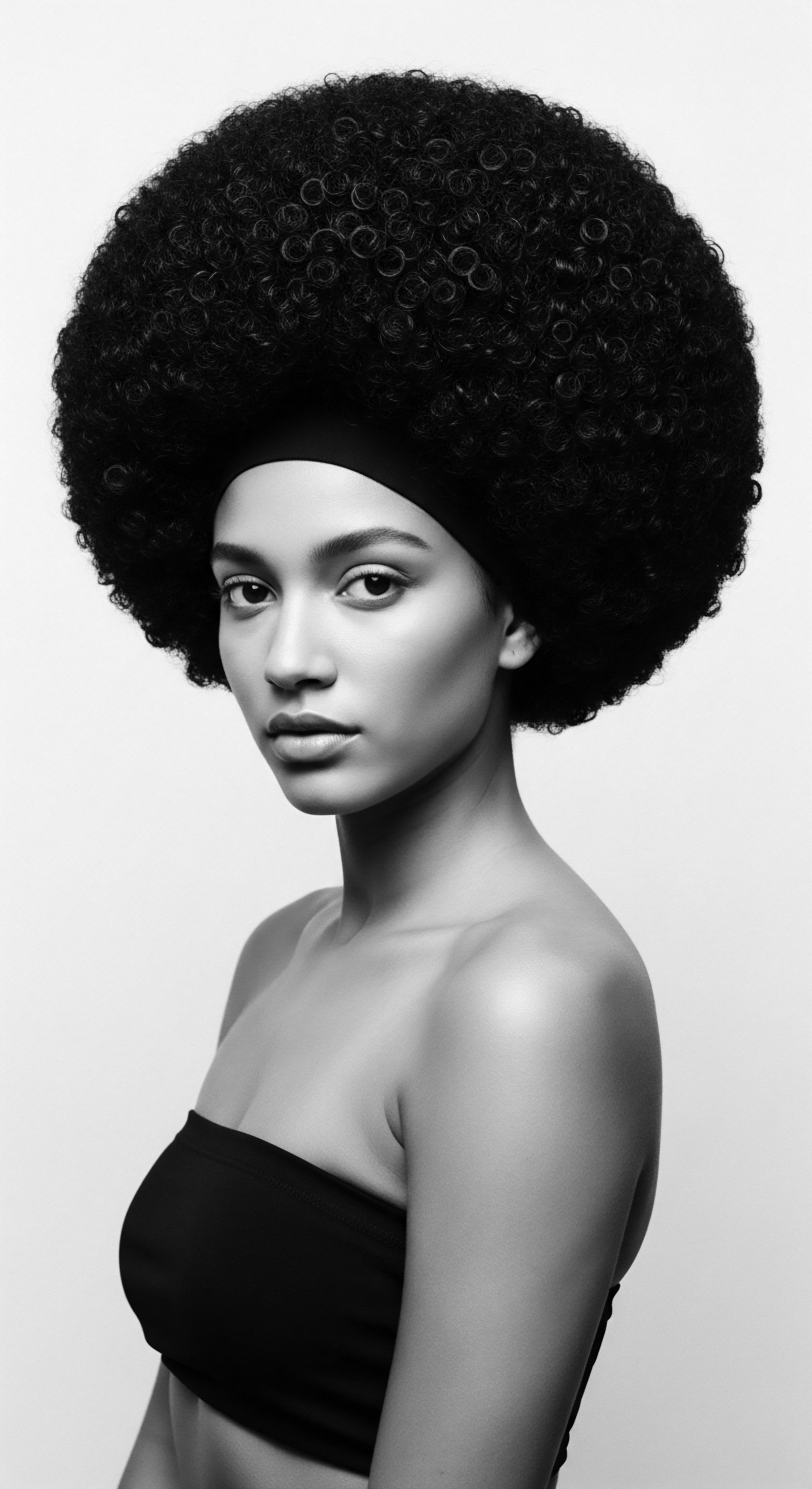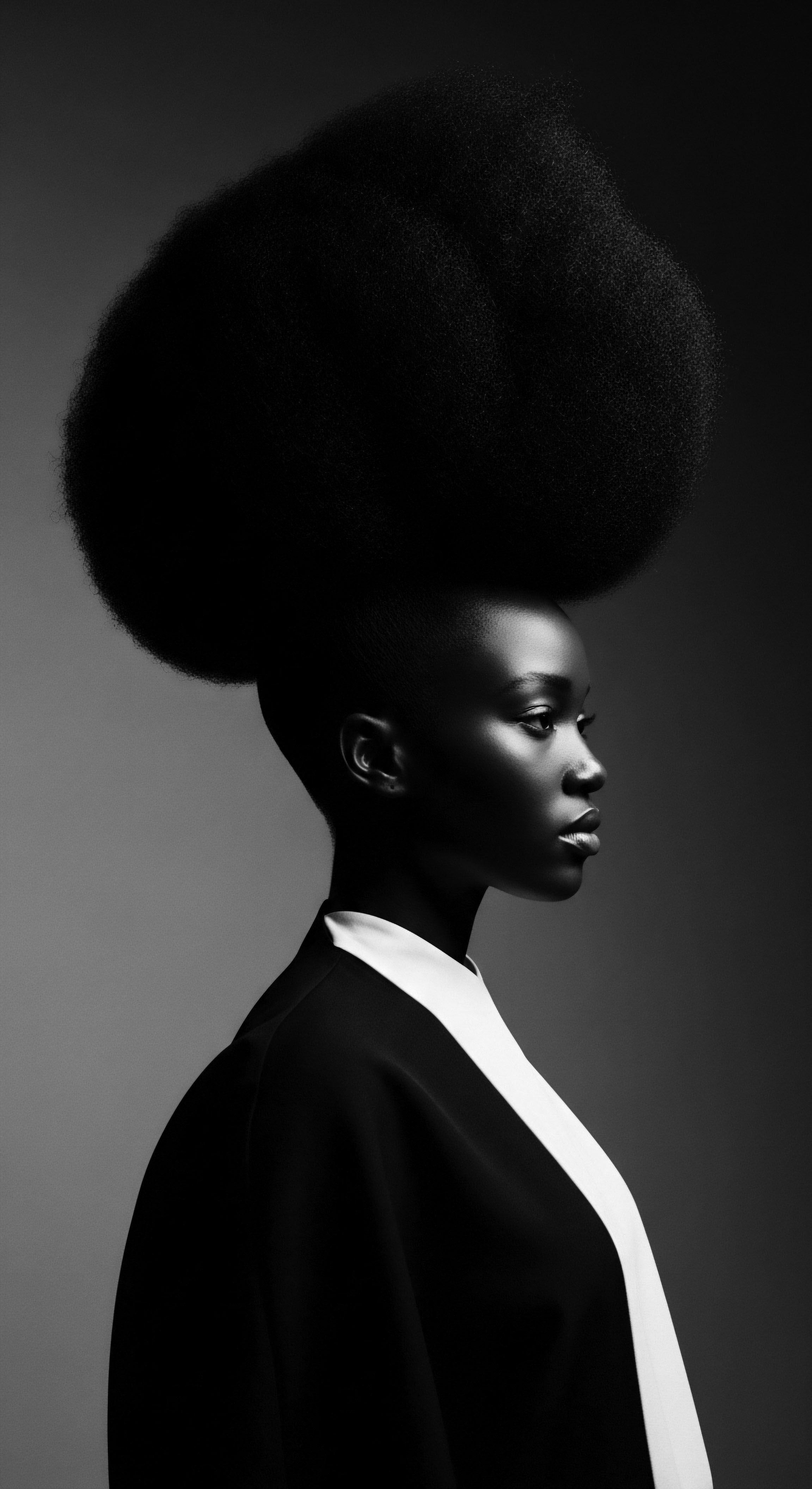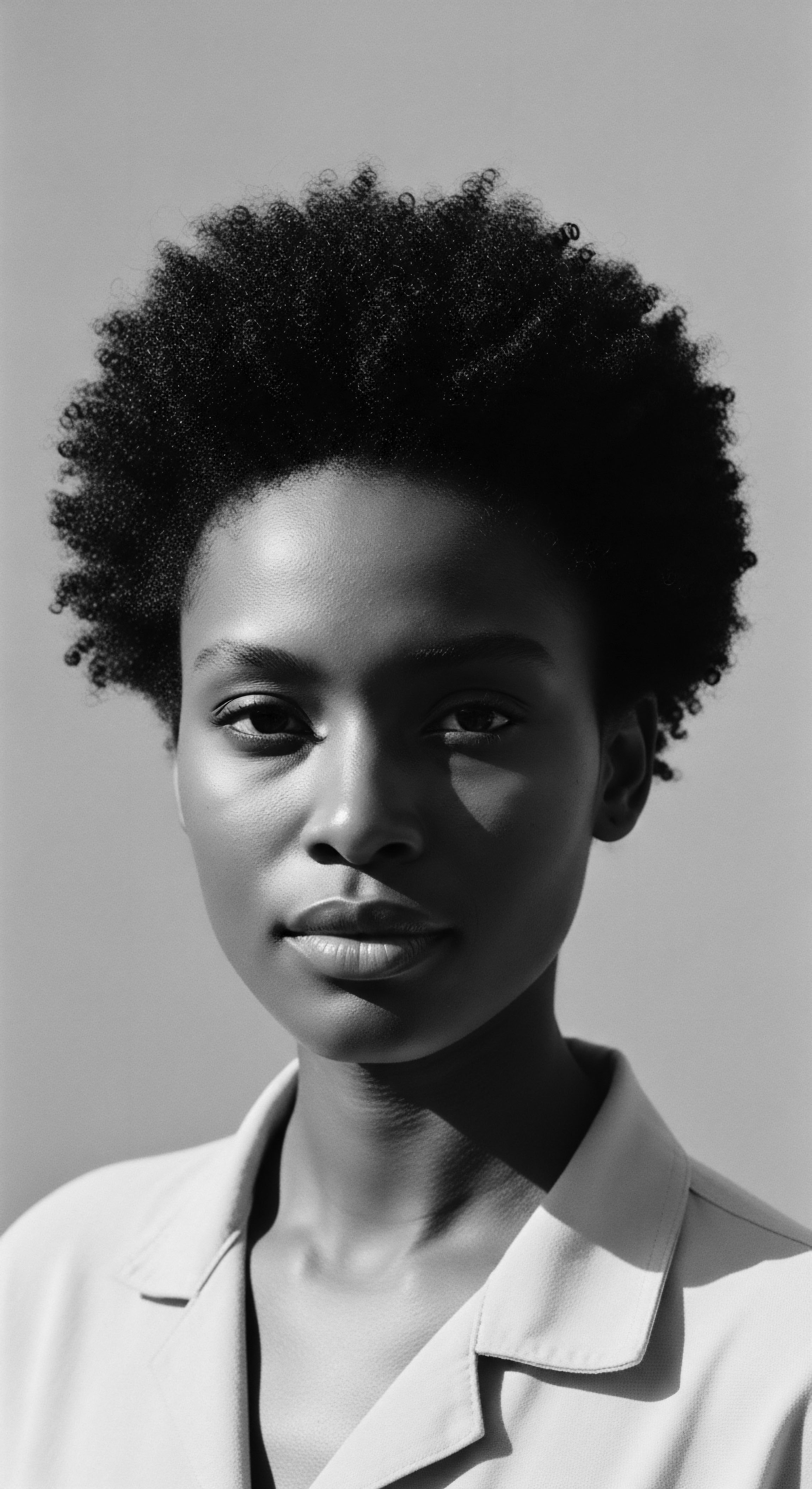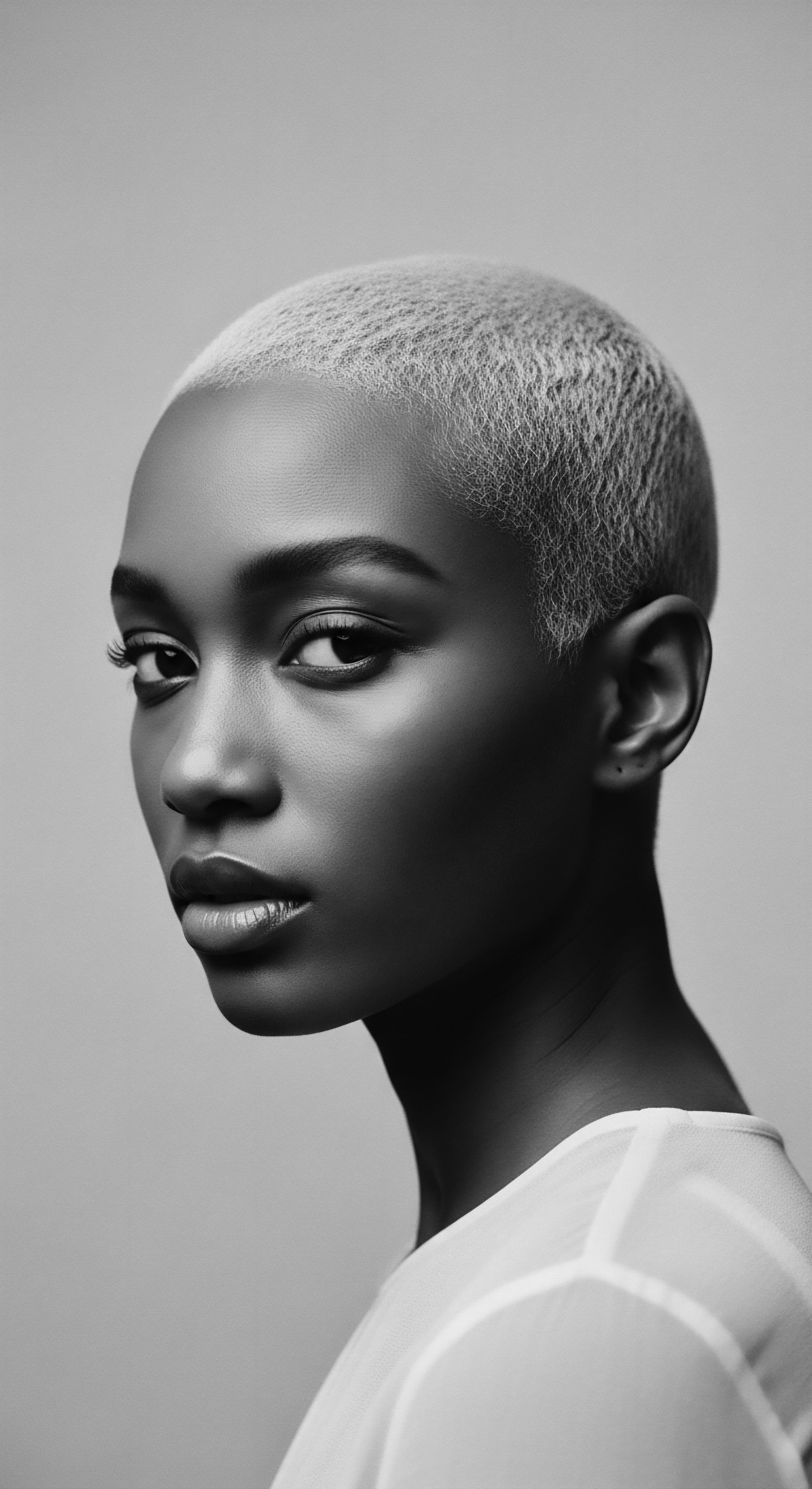
Fundamentals
Afro Hair Archeology, at its heart, offers a profound framework for understanding the deep historical, biological, and cultural narratives held within textured hair, particularly within Black and mixed-race communities. It means tracing the journey of kinky, coily, and curly strands from their earliest evolutionary advantages to their roles in ancient African civilizations, across the Middle Passage, and into contemporary expressions of identity. This area of study is a gentle, yet rigorous, exploration of hair as a living archive, a repository of ancestral knowledge, resilience, and beauty.
The concept extends beyond mere historical inquiry; it encompasses the tangible and intangible practices that have shaped, preserved, and given meaning to Afro-textured hair across millennia. It involves a discerning look at the elemental biology that grants textured hair its unique properties, alongside the time-honored rituals and communal activities that have sustained its care. This field provides an explanation for why textured hair possesses its particular characteristics, and how these attributes have been understood and celebrated within diverse cultural legacies.

The Root of Identity ❉ Early Meanings
For countless generations, hair served as a powerful visual language in pre-colonial African societies. It communicated an individual’s social status, age, marital status, tribal affiliation, and even spiritual beliefs. Hairstyles were not simply aesthetic choices; they were intricate symbols.
One could discern a person’s family background, their role within a community, or their readiness for marriage simply by observing their hair. The significance of hair was such that grooming practices often involved close relatives, as hair was thought to be a conduit for spiritual interaction and a source of personal power.
Archaeological findings reveal the enduring importance of hair and its care tools in ancient civilizations. Combs crafted from wood, bone, and ivory, some buried with their owners, attest to hair’s sacred status and the artistry involved in its styling. These artifacts, often bearing engraved symbols, communicated tribal identity, rank, fertility, or protection. Such discoveries from Kush and Kemet (present-day Sudan and Egypt) underscore how hair rituals connected individuals to their ancestors and deities.
Afro Hair Archeology reveals hair as a profound, living chronicle, echoing ancestral wisdom through its biology, cultural forms, and enduring spirit.

Early Practices and Their Enduring Wisdom
Ancient African communities developed sophisticated methods for textured hair care, relying on natural ingredients and a deep understanding of the hair’s needs. These practices were often communal, fostering social bonds and transmitting cultural traditions across generations. Women, in particular, would gather to style each other’s hair, transforming the act of grooming into a shared social activity that strengthened familial ties.
- Shea Butter ❉ A rich emollient, traditionally used for moisture and scalp health, its benefits recognized for centuries.
- Coconut Oil ❉ A versatile ingredient, employed for conditioning and promoting hair strength.
- Aloe Vera ❉ Valued for its soothing properties and ability to hydrate the scalp and strands.
- Natural Clays ❉ Utilized for cleansing and detoxifying the hair and scalp, drawing from earth’s resources.
This traditional knowledge laid the groundwork for contemporary natural hair care, demonstrating a continuous lineage of understanding about textured hair’s unique requirements. The biological characteristics of Afro-textured hair, with its tightly coiled strands and unique follicular structure, were understood through practical application long before modern scientific inquiry. Its natural configuration provides insulation, protecting the scalp from intense solar radiation and helping to retain moisture in arid environments, an adaptation believed to be among the earliest human hair types.

Intermediate
Stepping beyond the fundamental conceptualization, Afro Hair Archeology, at an intermediate level, expands into the intricate historical contexts that have shaped textured hair experiences, particularly within Black and mixed-race communities. This exploration deepens our understanding of how hair became a canvas for expression, resistance, and survival amidst shifting social landscapes, including the harrowing experiences of the transatlantic slave trade and subsequent colonial influences. It examines how ancient practices evolved, adapted, and sometimes went underground, yet persistently resurfaced as potent symbols of identity.

The Echoes of Displacement ❉ Hair as Resistance
The transatlantic slave trade marked a profound disruption, yet also a testament to endurance. Enslaved Africans endured forced head shaving, a deliberate, dehumanizing act intended to strip them of their cultural identity, tribal affiliations, and spiritual connections. Despite these oppressive circumstances, hair continued as a powerful symbol of resistance and cultural pride. Enslaved individuals, lacking traditional tools and ingredients, adapted by inventing new methods of care and styling.
They would hide seeds and even maps within intricate braids, literally weaving their heritage and paths to freedom into their hair. This covert practice underscores the ingenuity and tenacity of those who carried their ancestral knowledge through unimaginable trials.
Hair, in the face of forced erasure, became a living testament to memory, a silent language of survival and a map toward enduring freedom.
The practice of braiding as a form of communication is particularly compelling. For instance, rice farmers from West Africa, forcibly transported to Brazil and the Americas, braided rice seeds into their hair, ensuring the survival of staple crops and a link to their homeland. Cornrows, a style dating back to 3000 BCE in parts of Africa, were used to create intricate patterns that conveyed messages or mapped escape routes from plantations. This demonstrates the extraordinary ingenuity and practical application of traditional hair practices during periods of severe oppression.
| Period/Context Pre-Colonial Africa (15th Century) |
| Hair Practice/Style Ornate hairstyles |
| Cultural or Survival Significance Indicated social status, wealth, marital status, tribal identity, spiritual connection. |
| Period/Context Transatlantic Slave Trade |
| Hair Practice/Style Braiding seeds into hair |
| Cultural or Survival Significance Smuggling food, preserving cultural heritage, ensuring survival in new lands (e.g. rice seeds). |
| Period/Context Plantation Era (Americas) |
| Hair Practice/Style Cornrow patterns |
| Cultural or Survival Significance Coded messages, mapped escape routes, facilitated communication among enslaved people seeking freedom. |
| Period/Context 18th Century Louisiana |
| Hair Practice/Style Tignon headwraps |
| Cultural or Survival Significance Forced concealment due to Tignon Laws; transformed into symbols of protest and cultural expression through vibrant fabrics and adornments. |
| Period/Context These practices highlight the resilience and adaptability of Black communities, utilizing hair as a powerful medium for identity and resistance across historical challenges. |

Navigating Shifting Perceptions ❉ From Oppression to Affirmation
The journey of Afro-textured hair through history also involves navigating beauty standards imposed by colonial powers. After the transatlantic slave trade, Eurocentric ideals led to the perception of natural Afro-textured hair as “uncivilized” or “unprofessional”. This pressure led many to chemically straighten their hair using methods like hot combs and relaxers, often at considerable risk to hair health and scalp integrity. This period reflects a deep societal challenge where a person’s hair texture could impact their social and economic prospects, a stark reminder of historical biases.
However, periods of profound cultural affirmation emerged in response. The Black Power Movement of the 1960s and 1970s saw a powerful resurgence of natural hairstyles, with the Afro becoming a potent symbol of Black pride, defiance, and a rejection of imposed beauty norms. Figures like Angela Davis, whose Afro became iconic, inspired a broader acceptance and celebration of natural hair.
This shift was a collective declaration of self-acceptance and a reclamation of ancestral aesthetic. The natural hair movement, supported by digital platforms in recent decades, further continues this legacy, celebrating diverse textures and promoting care routines tailored to the intrinsic qualities of textured hair.

Academic
Afro Hair Archeology, at an academic stratum, represents a rigorous interdisciplinary field of study, meticulously analyzing the complex interplay of biological anthropology, cultural history, sociological dynamics, and material science as they pertain to textured hair within the African diaspora. This scholarly endeavor seeks to unravel the intricate layers of meaning, biological specificity, and historical agency embedded within the unique morphology of Afro-textured hair. It is an intellectual pursuit that acknowledges hair not merely as a biological appendage, but as a profound communicative system, an enduring cultural artifact, and a site of persistent sociopolitical contestation. The definition, at this level, extends to examining how hair functions as a conduit for collective memory and a symbol of identity, often affirming ancestral practices through the lens of modern scientific understanding.

Echoes from the Source ❉ The Biological and Evolutionary Tapestry
The biological distinctiveness of Afro-textured hair is a primary area of academic inquiry within this field. Research indicates that the tightly coiled, helical structure of Afro-textured hair, characterized by its elliptical hair follicle and an uneven distribution of keratin, represents a sophisticated evolutionary adaptation. This particular morphology provides superior protection against intense ultraviolet (UV) radiation and contributes to thermoregulation by creating an insulating layer of air around the scalp, preventing heat absorption while also allowing for air circulation to cool the head. It is theorized that this specific hair type may represent the earliest form of human hair, emerging as a survival advantage in equatorial climates.
(Caffrey, 2023). The biological nuances, including differential water absorption and mechanical properties, influence its unique hydration needs and susceptibility to breakage, necessitating specialized care approaches that historically have been developed through trial and error, now often validated by scientific investigation.
Microscopic analyses of hair follicles reveal that the more elliptical the cross-section of the hair follicle, the curlier the hair shaft, and conversely, rounder follicles produce straighter hair. In Afro-textured hair, the follicle itself often exhibits a distinct curvature. This shape means the hair strand twists as it grows, resulting in the characteristic coils, kinks, and zig-zags. The medulla, the innermost layer of the hair shaft, can be discontinuous or absent in some textured hair types, which can affect strength and elasticity.
Furthermore, the cuticle, the outermost protective layer, tends to be thinner and lift more readily in highly coiled hair, making it more prone to moisture loss and mechanical damage if not adequately protected and conditioned. Understanding these biological specificities is paramount for developing hair care strategies that honor the inherent qualities of textured hair.

The Tender Thread ❉ Sociocultural Semiotics of Care and Adornment
Afro Hair Archeology meticulously examines the complex semiotics of textured hair care and adornment throughout history. Hair, as a visible aspect of the human body, has served as a potent, non-verbal communication system within diverse African and diasporic communities. Hairstyles articulated one’s social standing, age, marital status, tribal affiliation, and even spiritual disposition, forming a rich lexicon of communal belonging. This cultural context means hair care was rarely an individualistic act but a communal endeavor, embodying social cohesion and the intergenerational transmission of knowledge.
- Communal Grooming Rituals ❉ These practices served as social gatherings, strengthening bonds between family members and community groups, fostering shared cultural identity.
- Spiritual Significance ❉ In many African belief systems, hair functions as a spiritual antenna, connecting individuals to ancestral realms and divine energies, making hair care a sacred act.
- Medicinal and Protective Applications ❉ Traditional ingredients such as shea butter, various plant oils, and natural clays were not merely cosmetic; they were deeply rooted in a holistic approach to hair health and protection against environmental elements.
- Symbolic Adornments ❉ Beads, cowrie shells, and intricate threading not only enhanced aesthetic appeal but also conveyed specific messages about social status, wealth, or life transitions within the community.
The systematic devaluation of Afro-textured hair during enslavement and colonialism constitutes a critical area of study. The forced shaving of heads and the imposition of Eurocentric beauty standards represented calculated attempts to strip individuals of their cultural identity and sever ties to ancestral heritage. Yet, even under such duress, hair practices became acts of profound resistance.
Enslaved African women, for example, intricately braided rice seeds into their hair as a means to carry and cultivate their native crops in new lands, securing both sustenance and a tangible link to their homeland (Byrd & Tharps, 2014). This instance speaks to hair’s capacity as a container of cultural memory and a tool for survival.

The Unbound Helix ❉ Hair as a Force for Identity and Future Expression
Academically, the Afro Hair Archeology paradigm explores how textured hair continues to shape contemporary identity politics and expressions of agency. The emergence of the natural hair movement, often spurred by social justice movements such as the Civil Rights and Black Power eras, marked a significant reclamation of inherent beauty and cultural pride. This period saw Afro-textured hair transform into a visible symbol of defiance against oppressive beauty standards and a powerful declaration of self-acceptance. The shift from chemically altered hair textures, driven by assimilationist pressures, to embracing natural coils and kinks, underscores a profound psychological and cultural re-alignment.
The path of Afro-textured hair, through history’s currents, illuminates a persistent quest for self-definition and liberation.
Contemporary research delves into the ongoing challenges of hair discrimination, despite legal protections like the CROWN Act in some regions. A specific study by the CROWN 2023 Research Study revealed that 41% of Black women reported altering their hair from curly to straight for job interviews, and a striking 54% felt they needed straight hair for such occasions (CROWN 2023 Research Study). This statistic, though from a recent study, casts a long shadow back to the historical biases that perceived natural hair as “unprofessional” or “unkempt,” illustrating a persistent societal pressure to conform to Eurocentric aesthetics. The sociological implications of hair-based bias extend to mental health and self-perception, making the study of Afro Hair Archeology a vital component of understanding systemic racism and its enduring effects.
Furthermore, academic inquiry within Afro Hair Archeology considers the technological innovations in hair care, from traditional homemade remedies using natural ingredients to the modern industry that caters to specific needs of textured hair. The ingenuity of Black inventors, such as Madam C.J. Walker, who created specialized products for African American women in the early 20th century, highlights a long history of self-determination in the face of systemic neglect by mainstream markets. This segment of the field not only documents the evolution of products but also examines the cultural entrepreneurship that emerged from a necessity to care for and celebrate Afro-textured hair.
The academic discourse, therefore, does not confine itself to the past; it investigates how historical narratives continue to inform and shape the present, influencing contemporary choices, artistic expressions, and ongoing movements for hair acceptance and liberation. The future of textured hair, viewed through this archeological lens, involves both understanding its origins and championing its unconstrained expression.

Reflection on the Heritage of Afro Hair Archeology
The journey through Afro Hair Archeology is a profound meditation on the enduring spirit of textured hair and the communities it has mirrored and sustained. Each coil and curl whispers tales of ancient forests, of ancestral hands crafting intricate patterns, and of journeys through time and geography. It reminds us that hair, far from being merely a cosmetic adornment, is a deep, living archive of our collective human story, particularly for those of Black and mixed-race heritage.
The biological marvel of its form, adapted for survival under the sun, holds echoes of our earliest beginnings. The ancient practices of care and communal styling speak of societies built on connection, reverence, and shared wisdom.
Even through periods of immense challenge and deliberate efforts to erase identity, the heritage of Afro-textured hair persevered. It transformed into a silent language of resistance, a hidden repository of hope, and a powerful emblem of defiance. This legacy, passed down through generations, continues to shape expressions of selfhood today, inviting individuals to embrace their unique strands with pride and purpose.
The exploration of Afro Hair Archeology allows us to connect with this unbroken lineage, fostering a deep appreciation for the ingenuity, beauty, and resilience that defines textured hair. It empowers us to carry forward these stories, ensuring that the soul of each strand continues to sing its timeless melody of identity and belonging.

References
- Byrd, A. & Tharps, L. (2014). Hair Story ❉ Untangling the Roots of Black Hair in America. St. Martin’s Press.
- Caffrey, C. (2023). Afro-textured hair. EBSCO Research Starters.
- CROWN 2023 Research Study. (2023).
- Dope Black. (2023, May 23). The History Of Black People Braiding Their Hair.
- Expedition Subsahara. Braids ❉ A Brief Cultural History.
- Gale Review. (2021, November 23). African Hairstyles – The “Dreaded” Colonial Legacy.
- Genesis Career College. (2024, January 16). History of Braids ❉ More Than Just a Hairstyle.
- Google. (n.d.). BLAM UK CIC ❉ The history of Black Hair. Retrieved from https://www.blamuk.org/the-history-of-black-hair
- Issuu. (n.d.). Celebrating the history and beauty of afro-textured hair. Retrieved from https://issuu.com/blackhistorymonthmagazine/docs/black_history_month_2023_online_magazine_pages_reduced/s/29524018
- Izzy & Liv. (2016, September 15). Timeline ❉ The Evolution of Black Hair.
- Noma Sana. (2024, October 30). The History of Straightening Afro Hair ❉ Culture, Trends & Identity.
- Odele Beauty. (2021, February 22). 6 Things Everyone Should Know About Black Hair History.
- Okan Africa Blog. (2020, October 8). The significance of hair in African culture.
- Refinery29. (2021, February 23). The Evolution Of The Natural Hair Movement.
- ResearchGate. (n.d.). Hair in African Art and Culture.
- Safo Hair. (2024, February 15). The Evolution of Black Hair Products ❉ A Journey from Homemade Remedies.
- Umthi. (2023, September 14). The Cultural Significance and Representation of Afro-Textured Hair:.
- YorkSpace. (2021, October 20). Braided Archives ❉ Black hair as a site of diasporic transindividuation.
